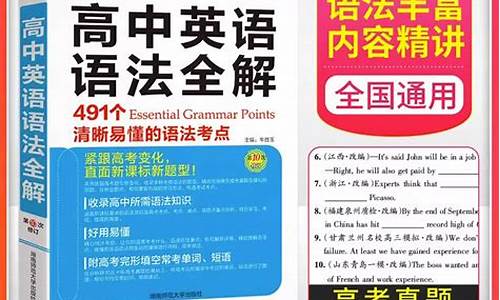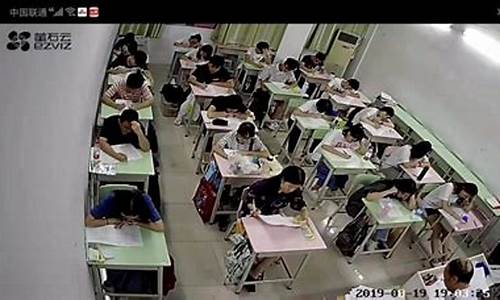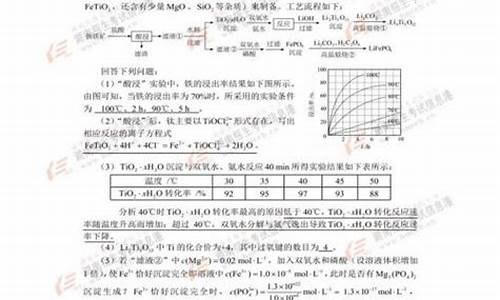高考英语 语法-高考英语语法知识大全
1.高中英语冠词语法知识点总结
2.求些高考英语常错 常混乱 知识点
3.高考英语语法填空进行时态知识点与必记的单词
4.高考英语语法考点总结
高中英语冠词语法知识点总结

高中英语冠词语法知识点总结
高中常用的冠词有哪些呢?下面由我为大家整理的高中英语冠词语法知识点总结,欢迎大家查看!
冠词
高考对冠词的考查集中在基本用法上,主要既反映在对泛指、特指及固定短语 冠词的考查。抽象名词、物质名词的具体化依然是高考的重点、难点。
一、不定冠词
不定冠词a,an与one同源,表示微弱的一的概念,但并不强调数目,用来表示不确定的人或事物。
A用在辅音前,而不是辅音字母前;an用在元音前,而不是元音字母前。
a university in Asia
1.表示同类中的任何一个
A cat has nine lives.
2.表示泛指的某人、某物
I know a John Lennon,but not the famous one.
3.表示数量的一 He has a daughter.
4. 表示单位数量的每一 I earn 10 dollars an hour.
5.表示相同的
The two birds are of a color.
6. 用于集体名词前
He grows up in a large family.
7. 在某种情况下可用于抽象名词和物质名词前 China has a long history.
二、定冠词的用法
1.表示特定的人或物
2.表示地球、宇宙中独一无二的事物
主要指各种天体及世界上比较有影响的物体。 The sun,the moon,the earth
3.表示地点、方向、时间、方式等 at the corner 在拐角处
1) 在表示季节的名词前常不用冠词。 In spring 在春天
2) 具体某年的某个季节,需用冠词。 In the summer of the year2008
3)用于序数词或形容词的最高级前 the first the second
4)用于形容词前使其名词化 the rich the poor
5)用于复数姓氏前,表示―夫妇‖或全家 The Smiths
6)用于乐器名词前 Play the piano
7)用于by+the+计量单位名词 By the pound
1. 用于复数名词前
复数名词泛指某类人或物时,其前通常用零冠词。 Students should obey the school rules. 学生应该遵守校规。 复数名词若需特指,则要加定冠词。 The students are too lazy. 这些学生太懒。
2. 用于不可数名词前
不可数名词表示泛指时,其前通常用零冠词。如: Bread is made from flour. 面包是用面粉做的。
Wood is a poor conductor of sound. 木头是声音的不良导体。 不可数名词若需特指,则要加定冠词。
He sawed the wood into three pieces. 他把木头锯成三块。
3.用于专有名词前
在通常情况下,专有名词前要用零冠词。如:
Mr Smith is our English teaches us English. 史密斯先生教我们英语。 在特殊情况下,若专有名词需要特指,也可加定冠词。如: The Smith you?re looking for no longer lives here.
4. 用于抽象化的可数名词前
有些可数名词抽象化后表示表示的活动,其前通常零冠词。 Jim has gone to bed. 吉姆已上床睡觉了。
She goes to church every Sunday. 她每周星期天都去做礼拜。
这类主要涉及bed, church, class, college, school, university, work, hospital, prison, market, sea, town等。另外,这类名词前用不用冠词有时与英美英语的表达习惯有关。如:―住院‖在英国英语中通常说成 in hospital,而在美国英语中则通常说成in the hospital;类似的还有go to university (英)上大学 / go to the university (美)上大学;at table (英)在吃饭 / at the table (美)在吃饭。
5. 用于职务及头衔前
当表示职务及头衔的名词用作表语、补足语及同位语时,其前通常用零冠词。如: Wilson became President of the U. S. A. 威尔逊当了。 He will be made captain of the football team. 他将被选为足球队队长。
6. 在表示学科、语言、三餐、月份、季节、节假日、星期等名词前,通常用零冠词。 We are all interested in physics. 我们大家都对物理感兴趣。 7. 用于某些固定结构中
go to sea 去当水手 at home 在家 at night 在晚上 at least 至少
at most 至多 at first 首先 at last 最后 in bed 在床上
on foot 步行 face to face 面对面
第二章 代词
高考中对代词的考查主要集中在人称代词(主要是其中的it)、关系代词、指示代词和不定代词上。
一、 it的用法 1.作人称代词
John likes playing Ping pong./ He always does it in the afternoon.(指代上下文提到的事物); /It's time we went home. / How far is it from here to your home ? / It is getting warmer and warmer./ It's very quiet at the moment.(可指时间、天气、环境等) 2.引导词
A.作形式主语,代替由不定式、动名词或从句表示的真正主语。
It's important for us to learn a second language./ It's no use talking to him./ It's known to all that the earth goes round the sun.
B.作形式宾语,代替由不定式、动名词或从句表示的真正宾语。
We feel it our duty to help others./ He made it clear that he would leave the city. C.强调结构:It is (was) +被强调部分+that (或who)?
注意:在强调结构中,如被强调部分为时间状语或地点状语,其后的连接词也绝不能为when 或where,而应用that 。在复习中,一定要注意句式的不同。 It was in Shanghai that I bought the guitar.(that引起强调句) It was Shanghai where I bought the guitar.(where引起定从)
It was twelve o'clock when we arrived there.(when引起时间状语从句) It was at twelve o'clock that we arrived there.(that 引起强调句)
3. it,one,that 的区别:作为代词,这三个词的对比使用是高考的热点之一。 ?Why don't we take a little break Didn't we just have __________? A.it B.that C.one D.this
The Parkers bought a new house but _________will need a lot of work before they can move in. A.they B.it C.one D.which
one 用以指代同类事物中的任一,that 特指性强,指代可数与不可数词,而it指代上文提过的同一事物。
二、 关系代词
who,whose,whom,which,that,as
1)which可以引导非限定性定语从句,代表前面整个句子的内容,并且在从句中做主语 2)that的用法 1)不用that的.情况
a) 在引导非限定性定语从句时。 b) 介词后不能用。
We depend on the land from which we get our food. We depend on the land that/which we get our food from.
2) 只能用that作为定语从句的关系代词的情况 a) 在there be 句型中,只用that,不用which。
b) 在不定代词,如:anything, nothing, the one, all, much, few, any, little等作先行词时,只用that,不用which。
c) 先行词有the only, the very修饰时,只用that。 d) 先行词为序数词、数词、形容词最高级时,只用that。. e) 先行词既有人,又有物时。
举例:
All that is needed is a supply of oil. 所需的只是供油问题。
Finally, the thief handed everything that he had stolen to the police. 那贼最终把偷的全部东西交给了警察。
3) as的用法
AS作关系代词,用来引导定语从句:限制性定语从句和限非制性定语从句 一、AS引导限制性定语从句
AS引导限制性定语从句时,通常和such, the same, as(so)等连用,构成such...as/such as, the same...as/the same as, as(so)...as等结构,在从句中可作主语,宾语和表语。
1.such...as/such as意为―...的那种...,像那样的‖,such...as/such as引导限制性定语从句时,既可指人,也可指物。such用于名词之前时,具有形容词性质;such单独使用(即后面不接名词)时,具有代词性质。
Don?t trust such men as praise you to your face.(as作主语) 不要相信那种当面吹捧你的人。
You should read only such books as you can understand without much difficulty.(as作宾语) 你应当只读那些你读起来不太难懂的书。
Associate with such as will improve your manners.(as作主语) 要和能改善你的言行的那种人结交。
2.the same...as/the same as意为―与...同样的‖,和such一样,the same既有形容词作用,又有代词性质。
We have arrived at the same conclusion as they have.(as作宾语) 我们已得出和他们同样的结论。
比较:the same...as和the same...that不同,前者是―同那一个相似‖,后者是―正是那一个‖。如:
This is the same watch as I lost. 这同我丢的那块表一样。
This is the same watch that I lost? 这正是我丢的那块表。
3.as(so)...as意为―和...一样‖,后接由many, much等修饰的名词或由形容词修饰的单数名词,注意其语序为as(so)+adj.+a+n+as,如: It?s as pleasant a film as I have ever seen. 这是一部和我以往看的同样好的**。
As many soldiers as marched were killed. 很多游行的战士都被杀了。
注意:such ...as与such...that ,so...as与 so...that的区别: that是连词,引出结果状语从句,在从句部分不作成分;as是关系代词,引出定语从句,在从句中可作主语,宾语和表语。比较: He is such a nice boy that everyone likes him. He is such a nice boy as everyone likes.
It is so difficult a problem that nobody can work it out. It is so difficult a problem as nobody can workout.
二、AS引导非限制性定语从句
AS引导非限制性定语从句时,通常指的不是主句中的某一个名词(先行词),而是指整个主句表达的内容,对主句所作的陈述进行附加说明,意为―这...,如...或正如...‖。这种从句可位于主句之前,之中或之后。
As we all know, Taiwan belongs to China. Taiwan, as we all know, belongs to China. Taiwan belongs to China, as we all know. 注意下面的习惯用法:
as is well discussed 正如已讨论过的
as is often said 正如通常所说 as is often the case 通常就是这样 as has been pointed 正如所指出的那样 as has been said before 如上所述 as often happens 如同经常所发生的那样 as might be expected正如所料 as is well known to all众所周知
在多数情况下,从句中的谓语助动词可以省略 as explained before 如前面所解释的 as mentioned above 如前面所提到的 as shown in the figure 如图所示 as seen from the table 从表中可以看出 as already discussed 正如已讨论过的 三、不定代词
一) . some 与 any 的用法
1. some 用于肯定句以及表示建议或期待得到肯定回答的问句。修饰单数名词时,意为某个。如:
I have some questions about the assignment. (希望得到肯定答复)。
2. any 用于否定句和疑问句时,表示一些。用于肯定句时,只和单数名词或不可数名词连用,表示任何。如:
The medicine is on sale every where. You can get it at any chemist?s. 二) . each 与 every 的用法
1. each 强调个体,表示两个或两个以上中的每一个,在句中可充当主语、宾语、定语和同位语。如:
There are trees and flowers at each side of the road.
2. every 强调整体,表示三者或三者以上中的每一个,只能作定语,不能说 every of them ,要说 every one of them .
Every student in our class works hard. 三 . no one 与 none 的用法
1. no one 意为没有人,只能指人,不能指物,不可与介词 of 连用,谓语动词用单数形式,回答 who 引导的问句。如: Who is in the classroom? No one.
2. none 既可指人,也可指物,强调数量,意为一点也不,一个也不;谓语动词既可用单数也可用复数;常与 of 连用,通常指三者以上的人或物中没有一个,回答 how much 和 how many 引导的问句。如:
They were all tired, but none of them would stop to have a rest. 四 . other, another, others, any other, the other 的用法
1. other 表示泛指,意为另外的、其它的。常与复数名词或不可数名词连用。如果其前有 the, this, some, any, each, every, no, one 以及形容词性物主代词时,其后就可接单数名词。如: I have no other place to go.
2. another 常用于指三者或三者以上中的另外一个,泛指单数。可单独使用,也可后接名词。如果其后接复数名词,则表示又、再、还。如: This cap is too small for me. Show me another (one)。 We need another three assistants in our shop.
3. others :它是 other 的复数形式,表示泛指,意为别的人或物,但不指全部。特指时在其前加定冠词;前面可加任何限定词以及数量词。如: He has more concern for others than for himself.
4. any other 表示一个之外的其他任何一个,而不是两个之中的另一个。如: China is larger than any other country in Asia.
5. the other :表示两者中的另外一个。可单独使用,也可接单数名词。如: No agreement was reached in the discussion as neither side would give way to the other. 五 . all 与 both 的用法 均表示都,但 all 表示三者以上的人或物, both 则表示两个人或物。二者都表示肯定意义,如果与 not 连用时,则表示部分否定。 六 . neither 与 either 的用法 都可用于表示两个人或物。 neither 表否定意义,意为(两者中的每一个)都不;而 either 表肯定意义,意为(两者中的每一个)都。都可单独使用,也可同介词 of 连用。如: Both teams were in hard training; neither willing to lose the game. Do you want tea or coffee? Either. I really don't mind.
求些高考英语常错 常混乱 知识点
高中英语语法速记口诀大汇总
一、冠词基本用法
速记口诀
名词是秃子,常要戴帽子,
可数名词单,须用a或an,
辅音前用a, an在元音前,
若为特指时,则须用定冠,
复数不可数,泛指the不见,
碰到代词时,冠词均不现。
妙语诠释 冠词是中考必考的语法知识之一,也是中考考查的主要对象。以上口诀包括的意思有:①名词在一般情况下不单用,常常要和冠词连用;②表示不确指的可数名词单数前要用不定冠词a或an,确指时要用定冠词the;③如复数名词表示泛指,名词前有this,these,my,some等时就不用冠词。
二、名词单数变复数规则
速记口诀
单数变复数,规则要记住,
一般加s,特殊有几处:
妙语诠释 ①大部分单数可数名词变为复数要加s,也就是单词如果以ch,sh,s,x等结尾),则一般加es;②以o结尾的单词除了两人(negro,hero)两菜(tomato,potato)加es外,其余一般加s;③以f或fe结尾的单词一般是把f,fe变为ve再加s;④英语中还有些单词没有规则,需要特殊记忆,如child—children,mouse—mice,deer—deer,sheep—sheep,Chinese—Chinese,ox—oxen,man—men,woman—women,foot—feet,tooth—teeth。
三、名词所有格用法
速记口诀
名词所有格,表物是“谁的”,
若为生命词,加“’s”即可行,
词尾有s,仅把逗号择;
并列名词后,各自和共有,
前者分别加,后者最后加;
若为无生命词,of所有格,
前后须倒置,此是硬规则。
妙语诠释 ①有生命的名词所有格一般加s,但如果名词以s结尾,则只加“’”;②并列名词所有格表示各自所有时,分别加“’s”,如果是共有,则只在最后名词加“’s”;③如果是无生命的名词则用of表示所有格,这里需要注意它们的顺序与汉语不同,A of B要翻译为B的A。
四、接不定式作宾语的动词
速记口诀
三个希望两答应,两个要求莫拒绝;
设法学会做决定,不要假装在选择。
妙语诠释 三个希望两答应:hope,wish,want,agree,promise
两个要求莫拒绝:demand,ask,refuse
设法学会做决定:manage,learn,decide
不要假装在选择:petend,choose
五、接动名词作宾语的动词
速记口诀
Mrs. P Black missed a beef bag. (P?布莱克夫人丢了一个牛肉袋。)
妙语诠释 该句话中每个字母代表了一个动词或短语,这些动词要求后面跟动名词作宾语。这些动词分别是:
M=mind, r=risk, s=succeed in,P=practice,B=be busy, l=look forward to,a=admit,c=can’t help, k=keep on, m=miss,i=insist on,s=suggest,s=stop,e=enjoy,d=delay,
a=avoid,b=be worth,a=advise,g=give up。
六、不定式作宾语补足语时省to的动词
速记口诀
一感,二听,三让,四看,半帮助
妙语诠释 一感:feel;二听:hear,listen to;三让:make,let,have;四看:see,notice,watch,ob-serve;半帮助:help。
七、形容词和副词比较等级用法
速记口诀
1. 比较级与最高级:两者比较than相连,三者比较the在前。
2.同级比较:同级比较用原形,as…as永不离;as…as加not,只言两者是同一,若是not so…as,后强前弱不看齐。
妙语诠释 ①比较级通常和than连用,而最高级通常跟有定冠词the;②同级比较一般用as…as表示“与…一样”,这时谁强谁弱不能比较出来,而not so…as则表示后者比前者强,翻译为“不如……”。
八、反意疑问句用法
速记口诀
反意问句三要点,前后谓语正相反;
短句not如出现,必须缩写是习惯;
最后一点应注意,短句主语代词填。
妙语诠释 ①反意疑问句的构成应该是“肯定的陈述句+否定的疑问”或“否定的陈述句+肯定的疑问”;②在短句中not必须与do,will,can等组成缩写形式;③在简短问句中,疑问句的主语必须是代词,而不能用名词形式。
九、感叹句用法
速记口诀
感叹句,并不难,what、how放句前;
强调名词用what,其余用how很简单。
妙语诠释 由what引导的感叹句一般修饰名词,而how引导的感叹句一般修饰形容词、副词或句子。
十、宾语从句用法
速记口诀
宾语从句须注意,几点事项应牢记。
一是关键引导词,不同句子词相异。
陈述句子用that;一般疑问是否(if,whether)替;特殊问句更好办,引导还用疑问词。
二是时态常变化,主句不同从句异。主句若为现在时,从句时态应看意;主句若为过去时,从句时态向前移。
三是语序要记清,从句永保陈述序。
妙语诠释 宾语从句应注意三点:①引导词,陈述句一般由that引导,这时的that可以省略;一般疑问句则由if或whe-ther引导;而特殊疑问句则由特殊疑问词引导。②时态,主句是现在时态,从句可用所需要的任何时态;但如果主句是过去时态,从句时态所表示时间一般往前移一个时间段。③语序,宾语从句永远要用陈述句顺序。
金题精练
1. My son got up late this morning. He only had _______ for breakfast.
A. two bread
B. two slice of bread
C. two slices of bread
D. two slices of breads
2. _______ room is big and bright. They like it very much.
A. Tom and Sam
B. Tom’s and Sam
C. Tom and Sam’s
D. Tom’s and Sam’s
3. —Do you know how many ___a horse has and how many _____ a bee has?
—Of course I know.
A. teeth; feet B. tooth; foot C. foot; teeth D. teeth; foot
4. __________ woman in a purple skirt is Betty’s mother.
A. The B. A C. An D. /
5. Now telephones are very popular and they are much ______ than before.
A. cheap B. cheaper C. cheapest D. the cheaper
6. —Hi, Tom. Is your brother as active as you?
—No, he’s a quiet boy. He is _________.
A. less outgoing than me
B. not so calm as
C. more active than I
D. as outgoing as I
7. English ____ in many countries, but Chinese ____ their own language.
A. is spoken; speaks
B. speaks; is spoken
C. is spoken; speak
D. is spoken; is spoken
8. The young man was often seen _______ by the lake.
A. to draw B. to drawing C. drawing D. drew
9. —So hot in the classroom. Would you mind ______ the window?
—OK, I’ll do it right now.
A. not closing B. not opening C. closing D. opening
10. —_______ weather! It’s raining!
—Bad luck! We can’t go climbing today.
A. What bad B. What a bad
C. How bad D. How a bad
Keys:1. C 2. C 3. A 4. A 5. B 6. A 7. C 8. C 9. D 10. A
高考英语语法填空进行时态知识点与必记的单词
时态(tense)是一种动词形式,不同的时态用以表示不同的时间与方式。它是表示行为、动作、状态在各种时间条件下的动词形式,在英语中有16种时态。我在这里整理了相关资料,希望能帮助到您。
高考英语语法填空进行时态知识点
进行时态
过去将来进行时的墓本概念、形式和用法
过去将来进行时(future-in-the-past continuous tense)表示在对过去某一时间而言的将来某一时刻或某一段时间正在进行的动作。
1)过去将来进行时的形式由should be(第一人称)或wonld be(第二、三人称)加现在分词构成。美国英语一律用wonld。
2)过去将来进行时的用法
a)表示在过去的将来的某一时刻或某段时间正在进行的动作。如:
He asked me what I should be doing at ten the next day.他问我第二天十点钟我将干什么。
They said that they would be expecting us the next week.他们说他们下个星期等我们去。
b)表示在过去某一时间之后即将或按计划进行的动作。如:
He said he could not come because he would be haying a meeting.他说他不能来,因为要开会。
一般时态与进行时态的区别
一般时态与进行时态的主要区别有二:
1)一般时态通常表示经常的动作或状态,而进行时态则表示在某一时刻或某段时间正在进行着的动作。如:
We read newspapers every day.我们每天读报。
She is now reading the newspaper.她现在正在读报。
2)一般时态表示主语的固有特征、能力等,而进行时态则表示主语在某一时刻或某段时间内所进行的具体动作。如:
He sings well.他唱得很好。
He is singing a folk song.他在唱一首民歌。
[注] 并不是所有的动词都能用进行时态,例如表达状态、感情和感觉的某些动词,通常只能用一般时态而不能用进行时态,例如"know"(知道)一般就不能用进行时态。这类动词还有be(是),have(有),1ove (爱),hate(恨),want(想要),1ike(喜欢),think(认为),believe(相信),see(看见),hear(听见)等。
现在进行时的基本概念
1)现在进行时表示此时此刻(说话人说话时)正在进行的动作,它并不表明这一动作从什么时候开始,到什么时候结束。汉语常用"(正)在"或"着"来表示这种时间关系。如:
What are you doing?
-I'm doing some washing.你在干什么?--我在洗衣服。
Look! It is snowing.瞧!下着雪哩。
She is drawing a map.她在画一张地图。
Are they listening to the music?
-NO,they are listening to the radio.他们在听音乐吗?--不,他们在听收音机。
2)现在进行时可表示现阶段正在进行着的动作,虽然此时此刻这个动作可能并不在进行。如:
He is working on a paper.他在写一篇论文。
They are compiling a dictionary.他们在编一本词典。
3)现在进行时有时可表示将来发生的动作,有"意图"或"打算"的含义(用于go,come,stay,1eave,start等表示移动的动词)。如:
He is corning to see you tomorrow.他明天要来看你。
They are going to the Ming tombs this coming Sunday.这个星期天他们要到十三陵去。
They are taking the children to the zoo on Sunday.他们星期天要带孩子们去动物园。
What are you doing next Sunday? I'm going on a picnic with my wife and daughter.这个星期天你要干什么?我要和妻子和女儿去野餐。
过去进行时的基本概念
过去进行时(past continuous tense)表示过去某一时刻或某段时间正在进行的动作。如:
I was practicing the violin at eight o'clock yesterday evening. 昨晚八点钟我正在练习小提琴。
When Walter arrived home,his sister was doing her homework.沃尔特到家时,他妹妹正在做作业。
Pat was watching TV all evening. 帕特整个晚上都在看电视。
过去进行时的形式
过去进行时由was(第一、三人称单数)或were (其余各人称和数)加现在分词所构成。
过去进行时的基本用法
表示在过去某一时刻或某一段时间正在进行的动作,这一特定的时间往往须用时间状语来表示。如:
She was reading an English magazine when I came in.我进来时她在看一本英文杂志。
It was getting dark.天黑了。
They were working all day yesterday.他们昨天整天工作。
We were cleaning the auditorium from 7 to 9 last night.昨晚七点到九点我们在打扫大礼堂。
I met him when he was crossing the street.他过街时我碰见他。
过去进行时的其他用法
1)表示移动的动词go,come,start,stay,leave等的过去进行时,可以表示过去将来发生的动作。如:
They wanted to know when we were leaving for Shanghai. 他们想知道我们什么时候到上海去。
She asked whether he was starting then ext day.她问他是否第二天就动身。
2)动词go的过去进行时态加动词不定式,可以表示在过去某一时间之后将要发生的动作。(比较8.24的3)如:
They said they were going to set up a nursery.他们说他们要设立一个托儿所。
She said the foreign guests were going to visit the Shanghai in dustrial Exhibition.她说外宾要去参观上海工业展览会。
The monitor announced that our new teacher was going to speak to us.班长宣布新老师要跟我们讲话。
3)过去进行时可用来描写故事发生的背景。如:
It was a dark night. The wind was blowing hard and the rain was falling heavily. A young woman suddenly appeared on the riverbank. it was Xier. She had just escaped from Huang Shiren's house.那是一个漆黑的夜晚。风刮得很厉害,雨下得很大。一个年轻妇女突然出现在河岸上。这就是喜儿。她刚从黄世仁的家里逃了出来。
过去一般时与过去进行时用法比较
过去一般时通常表示过去发生的一个单纯的事实,而过去进行时则表示在过去某一时刻或某段时间正在进行的动作,强调在这一过程中所进行的动作或展开的情景。试比较:
We built a bridge last winter.去冬我们修了一座桥。(意即去冬我们做了这件事,桥已经修好了。)
We were building a hydro-electric station last winter.去冬我们在修水电站。(意即去冬我们一直在修水电站,修完与否不详)
I wrote a letter home last night. 昨晚我写了一封家信。(意即)昨晚我做了这件事,信写完了。)
I was writing a letter to my pen friend in America last night. 昨晚我在给我的美国笔友写信。(意即昨晚我一直在写信,不一定写完)
语法填空识记单词
1. appear:v.出现 ? (appearance)n.外貌;出现
2. give - gave - given 给
3. think - thought - thought 认为
thought:n.思想,想法?(thoughtful)adj.深思的;体贴的
4. leave - left - (left)留下
5. close:adj.近的 ? (closely) adv.近
6. tradition:n.传统 ? (traditional) adj.传统的
nutrition:n.营养 ? (nutritional) adj.有营养的
nature:n.自然 ? (natural) adj. 自然的
person:n.个人 ? (personal) adj.个人的?(personally)adv.就个人而言
7. happy:adj.高兴的 ? (happiness) n.幸福 ? (happier) adj.更高兴的 ?(happier为happy的比较级,be happy with ... 对...满意)
8. color:n.颜色,彩色 ? (colorful) adj.彩色的
care:n.护理 ? (careful) adj.小心的 ? (carefully) adv. 小心
use:n.用处 ? (useful)adj.有用的
wonder:v.想知道;n.奇迹 ? (wonderful)adj.精彩的? (wonderfully) adv.极好地
9. luck:n.运气 ?(lucky)adj.幸运的 ? (luckily) adv.幸运的是 ? (unluckily) adv.不幸运的是(but提示)
10. fortune:n.运气 ? (fortunately) adv.幸运的是 ?(misfortune)n.不幸
? (unfortunately) adv.不幸运的是(but提示)
11. eat:v.吃 ? (eating)(为eat的动名词) n.吃? eat - ate - eaten
12. call:v.把...称为 ? (called) (为call的过去分词)
13. grow - grew - grown 生长 ? (growth) n.生长
14. especial:adj.尤其的,特殊的 ? (especially) adv.尤其
15. sell - (sold) 卖; buy - (bought) 买
16. main:adj.主要的 ? (mainly) adv.主要
17. educate:v.教育 ? (education) n.教育
18. feel - (felt) 感到;fall - (fell) 落下
19. practice:v./n.练习 ? (practically) adv. 实际上
20. recover:v.恢复 ? (recovery) n.痊愈
21. survive:v.幸存 ? (survival)n.幸存 ? (survivor)n.幸存者
22. understand - understood - understood 理解 ? (misunderstand) 误解
23.(responsible) adj.有责任感的 ? (responsibility)n.责任感 ? be responsible for 对...负责
24. able:adj.有能力的 ? (ability) n.能力
25. honest:adj.诚实的 ? (honestly) adv.诚实地 ?(honesty)n.诚实
26. fool:v.愚弄;n.傻瓜 ? (foolish) adj.愚蠢的
27. dead:adj.的 ? (deadly) adj. 致命的
28. tell - told - told 告诉;sell - (sold)
29. avail:v.有益 ? (available) adj.可利用的
reason:n.原因 ? (reasonable) adj. 合情合理的
30. please:v.使...高兴;请 ? (pleased)adj. 高兴的 ? (pleasure) n.愉悦 ?(pleasant)adj.令人愉快的
31. accept:v.接受 ? (acceptance) n.认可,接受
32. win - won 赢;differ:v.不同 - (different) adj.不同的
33. break - broke - broken 打碎
34. wear - (wore) - worn 穿
tear - (tore) - torn:v.撕破;流泪 n.眼泪
35. loss:n.损失 ? lose:v.丢失;迷失 ? lost:adj.迷路的;丢失的
36. wood:n.木材 ? (woody) adj.木质的
37. regular:adj.有规律的,定期的 ? (regularly) adv.定期
38. possible:adj.可能的 ? (possibly) adv.可能地
probable:adj.可能的 ? (probably) adv.可能地
terrible:adj.可怕的 ? (terribly) adv.可怕地
simple:adj.简单的 ? (simply) adv.简直;简单地
39. surprise:n.惊喜;v.使吃惊 ? (surprisingly) adv.惊人地
increase:v.增加 ? (increasingly) adv. 日益增加地
40. actual:adj.实际的 ? (actually) adv.实际上
41. sudden:adj.突然的 ? (suddenly) adv.突然
42. fall- (fell) - fallen 落下
43. build - built - (built) 修建 (rebuild:v.重建)
44. slow:adj.慢的;v.减慢 ? (slowly) adv.慢地
45. blood:n.血液 ? (bleed) v.流血
46. effect:n.效果 ? (affect) v.影响
have an effect on sb 对...有影响
47. perform:v.表演 ? (performer) n.表演者 ? performance n.表演
48. decide:v.决定 ? (decision) n.决定
49. contribute:v.贡献 ? (contribution)n.奉献(to)
50. develop:v.发展 ? (development)n.发展(with)
51. assist:v.帮助 ? (assistant)n.助手
52. arrive:v.到达 ? (arrival)n.到达
高考英语语法考点总结
《高考英语语法》百度网盘免费下载
链接: 提取码: 28ue ?
高考英语语法(全民尊享版)
声明:本站所有文章资源内容,如无特殊说明或标注,均为采集网络资源。如若本站内容侵犯了原著者的合法权益,可联系本站删除。












